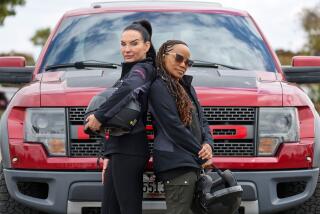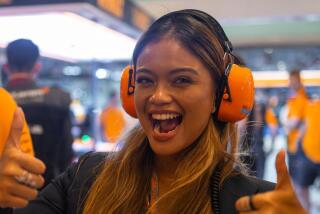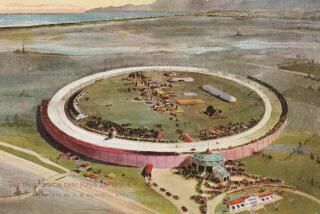The Speed Queen
- Share via
There was only one woman in this year’s Indianapolis 500, and none in the Daytona 500, the Monaco Grand Prix or the 24 Hours of Le Mans. In fact, outside of drag racing, the only woman driver who ever dazzled the wide world of motor sports is a six-time great-grandmother from West Covina who did it in 1959.
That year, when women weren’t even permitted in the pits at Indy, Faye Pierson won a heat race and finished second overall in the first go-kart national championships. Immortalized as the Ladybug (because she drove a kart built by Bug Engineering), she humbled alpha males in five countries before being enshrined in the World Karting Assn. Hall of Fame.
“She was always the one to beat,” says San Gabriel Valley karting pioneer Duff Livingstone, now of Grants Pass, Ore. “Of course, she only weighed about 10 pounds. But she was a good driver and a helluva competitor.”
Pierson, who cuts a stylish figure in a ponytail and faded blue jeans, is remarkably effervescent and still girlish for a woman in her 70s. (She declines to be more specific about her age, though she admits to having those half-dozen great-grands.) She’s still racing, too: She recently finished third behind two men half her age in the Vintage Kart Olympics in West Quincy, Mo.
“I held them off for about half the race until they both freight-trained by me,” she says. “The idea is to have fun, but I still run as hard as I can. I’m not as fast or brave as I used to be in the corners. But I flatfoot it all the way down to the turns.”
Stop snickering. These little road rockets aren’t to be confused with the kiddie contraptions found at amusement parks. They are serious race cars capable of 80 mph that just happen to be very, very small. The first three finishers at this year’s Indy 500 cut their teeth in karts. So did five-time Formula 1 world champion Michael Schumacher. And NASCAR mega-star Jeff Gordon. Elsewhere in the world, karts are considered the first rung of the professional motor-sports ladder, not to mention the planet’s most plentiful, most egalitarian and, arguably, most entertaining racing machines. Only in the United States are they dismissed as tame children’s toys, which is weird since the go-kart was born right here in Southern California.
The first kart was created in 1956 by Art Ingels, a fabricator at the mighty Kurtis-Kraft Indy race car shop in Glendale. Ingels had picked up a lawnmower engine for $5. For fun, he welded some steel tubing into a rectangular frame, stuck four tiny wheels on the corners, plopped a seat down in the middle and mounted the motor behind it. The kart was born.
But if Ingels was the go-kart’s creator, then Livingstone was its patron saint. An enterprising WWII combat veteran who co-owned several Southern California muffler shops, Livingstone was so wowed by Ingels’ invention that he decided to build one. Two friends followed suit, after which Livingstone called Ingels and said: “Hey, why don’t we meet down at the Rose Bowl [parking lot], and we’ll have some fun?”
Passers-by went gaga over the pint-sized race cars, and Livingstone decided to capitalize on the furor. He drew a set of plans on a grocery bag, and commercial artist Lynn Wineland came up with potential names, among them zip kart, go kart, fun kart and dart kart. Before long, the freshly minted Go Kart Manufacturing Co. was selling kits for $129.50.
On Christmas Day in 1957, Pierson drove a neighbor’s newfangled Go Kart. “They couldn’t get me off of it,” she says, her eyes bright as she recalls this life-altering experience. “I’d never had so much fun in my life. You put your foot to the floor and, geez, it was just exhilarating!”
Shortly after this epiphany, Pierson and her late husband, Tom, founded Bug Engineering, and he built its first kart from scratch in his garage. Bug later morphed into K&P; Manufacturing in Azusa, which is the world’s oldest kart manufacturer (Go Kart Manufacturing went out of business in the early 1960s) and which Pierson’s sons, Tommy and Jon, still run.
Pierson started racing on the parking lots of the San Gabriel Valley. “On Sundays,” she recalls, “we might go to two or three of them because we kept getting kicked out.” By the time Go Kart Raceway opened in Irwindale in 1959--the world’s first purpose-built kart track--she was a marquee attraction. And when the first nationals were held there later that year, a writer at the time reported, “She stole the meet.”
Back then, mind you, women were persona non grata in many forms of racing. Even when they were permitted to compete, they often were segregated into “powder-puff derbies.” Yet there was Faye Pierson, whipping all comers from coast to coast, as well as in Mexico, the Bahamas, England and Italy. “Some of the guys went out of their way to beat me or crash me out of the race,” she says. “But most of them didn’t seem to mind racing against a girl. The sport had evolved so casually that it just wasn’t an issue.”
In 1962, Pierson was injured while testing a sports car at Riverside International Raceway. It took her a year to recover, and her husband didn’t want her to race anymore. So she quit, and we’ll never know what might have been. Talent is only part of the professional race-car driver’s toolbox, though. You also have to want to win no matter how bitter the setbacks or how savage the costs. “I see a lot of girls [in karting] who are really good,” Pierson says. “But then they get to be 18 or so, and their interests change.”
Two years ago, seduced by the potent pull of nostalgia, Pierson started racing again and found herself treated like a celebrity at vintage kart events. Several men told her that she’d once been their hero. “I don’t understand it,” she says. “Why would a teenage boy pick me as an idol?”
Maybe because she was a woman. Or maybe in spite of it.
More to Read
Go beyond the scoreboard
Get the latest on L.A.'s teams in the daily Sports Report newsletter.
You may occasionally receive promotional content from the Los Angeles Times.










